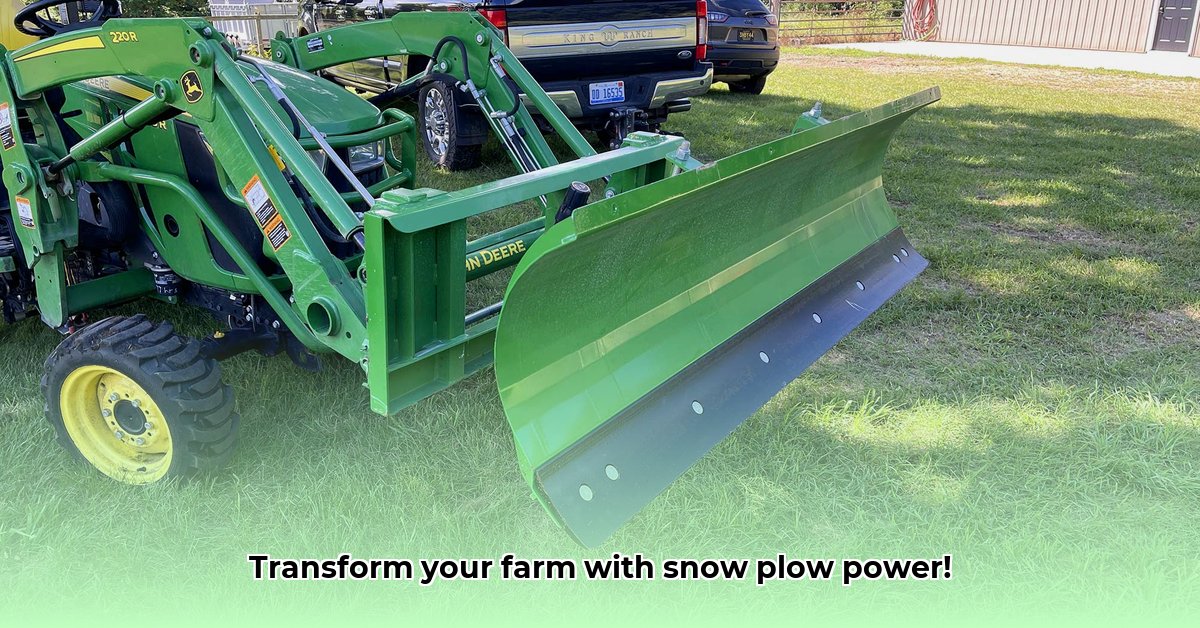
Snow Plow Tractor Attachments: A Guide to Efficient and Sustainable Snow Removal
Winter's harsh realities often disrupt farm operations, with snow accumulation significantly impacting access to fields and delaying crucial tasks. However, effective snow removal doesn't have to be a major hassle or an unsustainable expense. This guide explores how snow plow tractor attachments provide a practical solution for maintaining farm productivity while promoting environmental responsibility. We'll cover selecting the right attachment, safe installation and operation, proper maintenance, and minimizing the environmental footprint of your snow removal efforts. For more in-depth information, check out this helpful resource.
Choosing the Right Snow Plow Tractor Attachment
Selecting the appropriate snow plow attachment is paramount for both efficiency and safety. Several factors influence your decision, impacting your farm's productivity and your budget.
First, tractor compatibility is crucial. Consult your tractor's manual to determine the recommended weight and size limits for attachments. Overloading your tractor can lead to damage and safety hazards. Secondly, budgetary considerations are essential as prices vary considerably depending on the blade material, size, features (such as angling capabilities), and brand. Finally, expected snowfall dictates the necessary plow capabilities. Light, occasional snowfall might necessitate a less powerful plow, whereas areas with frequent, heavy snowstorms need more robust options.
Here's a breakdown of common snow plow attachment types:
Straight Blades: These are simple, durable, and cost-effective, ideal for straightforward snow removal in relatively flat areas. Their simplicity makes maintenance straightforward.
V-Shaped Blades: Designed for efficiency, especially in heavy snowfall. The V-shape directs snow to the sides, creating a wider cleared path. They are better suited for powerful tractors.
Push/Angle Blades: These versatile options allow both straight pushing and angled snow movement, making them useful for complex landscapes with obstacles. While more expensive, their flexibility offers unique benefits.
A comparative table summarizes their pros and cons:
| Snow Plow Type | Pros | Cons |
|---|---|---|
| Straight Blade | Simple, affordable, durable, easy to maintain | Less maneuverable, less efficient in heavy snow |
| V-Shaped Blade | Efficient snow movement, good for heavy snow | More expensive, requires a more powerful tractor |
| Push/Angle Blade | Versatile, adaptable to various conditions | Most expensive, can be more complex to operate |
Installing and Operating Your Snow Plow: A Step-by-Step Guide
Successful installation and safe operation are crucial for effective snow removal. Always refer to your specific plow's instruction manual, as procedures may vary slightly. These general steps provide guidance:
Prepare Your Tractor: Ensure the tractor is on a level surface, engine off, and parking brake engaged.
Raise the Three-Point Hitch: Raise the three-point hitch (the system connecting the plow to the tractor) fully.
Align the Plow: Carefully center and level the plow beneath the three-point hitch.
Secure the Attachment: Engage the quick-attach system according to the manufacturer's instructions, ensuring a secure lock.
Lower the Plow: Slowly lower the plow using the tractor's hydraulic system, adjusting the angle as needed.
Test the Attachment: Before clearing snow, test the attachment in a safe area to verify stability and functionality.
Safety is paramount. Always wear appropriate safety gear, including sturdy boots, gloves, and protective eyewear. Clear the area of obstructions before operation and avoid operating the plow without adequate training. Remember, a moment's carelessness can have significant consequences.
Maintaining Your Snow Plow: Ensuring Longevity and Performance
Regular maintenance significantly extends your snow plow’s lifespan and ensures optimal performance.
Inspect Mounting Hardware: Regularly check all bolts and connections for tightness, tightening any loose components.
Lubricate Moving Parts: Keep hydraulic components and moving parts well-lubricated to minimize wear and tear.
Clean the Blade: After each use, remove snow and ice from the blade to prevent corrosion.
Store Properly: Store the plow in a dry, protected location to prevent rust and damage.
Sustainability Considerations: Minimizing Your Environmental Impact
While tractors might seem less environmentally friendly than smaller machines, they offer significant sustainability advantages. Modern tractors often feature improved fuel efficiency over smaller gas-powered snow blowers, reducing your carbon footprint.
Efficient snow removal techniques, such as minimizing passes over the same ground, reduce soil compaction. Selecting a snow plow that requires less hydraulic power further enhances sustainability. Remember, a single efficient pass is often superior to multiple passes with smaller equipment, conserving energy and reducing emissions. Timely access to fields also maximizes harvest potential and reduces crop waste, contributing to overall farm sustainability.
Conclusion: A Strategic Investment in Farm Efficiency and Sustainability
Investing in a snow plow tractor attachment offers a strategic advantage for farms facing winter challenges. By carefully selecting the right attachment, adhering to safe operating procedures, and implementing regular maintenance, you ensure efficient snow removal, minimize your environmental footprint, and maintain consistent farm productivity throughout the winter months. This investment pays off through increased efficiency, reduced operational costs, and environmental responsibility.